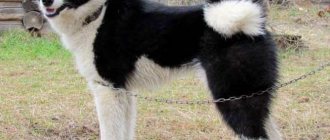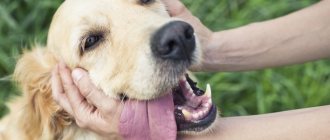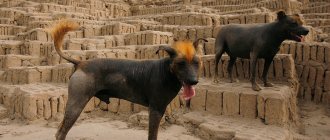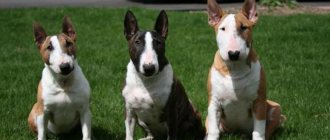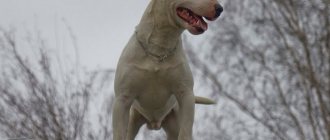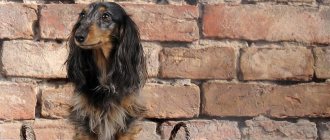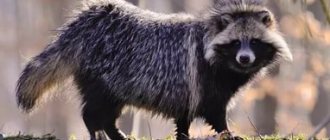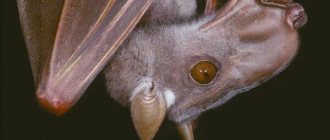Shalaika, also known as Sulimov's dog, Shakalaika or simply Shabaka, was bred for one purpose - to obtain an ideal bloodhound and fully met the expectations of the author of the breed, Klim Timofeevich Sulimov. Shalaika is a small, energetic dog with an independent character and an outstanding sense of smell, unpretentious, hardy and hard-working. Today it is bred only in one nursery, where you cannot buy a puppy.
The history of the appearance of the jackal dog
Klim Sulimov is a scientist and dog handler who developed the Shalaika breed
Shalaika is a new breed of dog. It was officially registered and recognized by the RKF in 2022, but its history began much earlier.
We owe the appearance of the shalayka to a Russian biologist engaged in research in the field of cynology, Klim Sulimov. He created a hybrid of a jackal and a dog. Work began in 1973. Initially, the goal of this selection was to obtain a super dog that would help fight drug trafficking and illegal trade in rare wild animals. It was necessary to create a bloodhound with a unique sense of smell, capable of working in any conditions.
For these purposes, Sulimov chose the Central Asian common jackal and the Nenets reindeer herding dog (Laika). This was explained by the following factors:
- The jackal is 60% herbivore and has an excellent sense of smell for various plants, including those from which drugs are produced. In addition, it can live in hot conditions and can easily tolerate temperatures of 40 degrees. The jackal is small in size, which was also important for selection. The animal had to quietly crawl under the seats on the plane, without attracting people's attention while working.
- The reindeer husky also has a good sense of smell, has high intelligence, and can live and work in conditions down to minus 60–70 degrees.
But it was not possible to achieve the crossing of adult jackals and huskies - wild animals did not accept dogs. It was necessary to adapt them.
To do this, it was decided to take four-day-old jackal puppies for breeding and feed them to the husky. The kids grew up and recognized the dogs as their own. Selection work was carried out for 7 years. As a result, they managed to get the first offspring, which were half dogs, half jackals. But the individuals turned out to be unsuitable for training and work - they had too many genes of a wild animal that is terribly afraid of people.
The hybrids were once again crossed with a husky and obtained offspring that were only 25% jackal. These were the first puppies of Sulimov's dog, which were quickly dubbed Shalaykas.
These dogs are also called “quaterons” - from “quart”, that is, “quarter”. Other names for the breed are Shakalaika, Shabaka. The official name is jackal-dog.
The new dogs took the best from both the jackal and the husky. They are small, nimble, very smart, easily tolerate any natural conditions, and thanks to their small size they can crawl into any crevice. Their only drawback was that the dogs did not become attached to people - they could work well, but they did not perceive humans as owners. But it turned out that this is even better for the service - jackalaikas can calmly interact with various canine specialists.
Shalaika perfectly follows the commands of any dog handler working at the airport.
Sulimov's dogs are bred in the kennel of the Aeroflot security service at Sheremetyevo Airport; now about 50 dogs live and work there. All conditions for living and training have been created for the animals. There are special rooms where situations for searching for harmful substances are simulated, and even an airplane in which the skill of searching for dangerous and unauthorized items is honed.
In the 80s and early 90s, dogs were successfully used to search for narcotic substances, with success rates reaching 95%. Shakalaikas also helped to find illegally transported animals or their parts (derivatives).
Sulimov's dogs have a unique sense of smell; they can even distinguish between traces of men and women by smell, which was of great assistance to law enforcement agencies.
In 2002, Russia faced the problem of terrorist attacks. It turned out that jackalaikas can help here too - detecting explosives even in minimal concentrations. Animals were specially trained to find hexogen, and they began to work in this direction.
Sulimov's dogs identify hexogen with great accuracy: for example, false recognition accounts for 1 case out of 200.
Video: Sulimova's super dog
Nutrition
The diet of Sulimov’s dogs takes into account the natural preferences of the original species: jackal and husky. The Asian jackal is practically omnivorous and does not disdain carrion and food scraps from garbage dumps. The Nenets Laika prefers food of animal origin.
Balanced food is prepared in the kitchen that exists in the kennel for service dogs. The four-legged diet contains natural meat, fish and other protein products. Vegetables are added. Vitamins and minerals are used as additional additives.
Description of the breed according to the RKF standard
The main job of the shalaika is to detect explosive or dangerous substances
The breed standard was approved by the Decision of the Presidium of SOKO RKF on June 15, 2018. Shalaika according to the FCI classification belongs to the fifth group - “Spitz and primitive dogs”.
The purpose of breeding is detection (recognition) of odors. The dog is intended for official use and airport security work.
Shabaka in appearance resembles a medium-sized husky and is below average in height. The animal is of regular build, agile, harmonious, almost square in format. The ratio of body length to height at the withers is 10:9. The difference between males and females is not particularly pronounced outwardly.
Size and weight:
- height 38–42 cm (deviation within 3 cm is allowed);
- weight not less than 7 kg and not more than 15 kg.
The peculiarity of the dog's appearance: in its muzzle and head structure it is similar to its wild relatives - jackals. This is expressed in the look, the shape of the eyes, facial expressions, and mobile, medium-sized erect ears.
The shawl has a non-massive muzzle with very well developed whiskers (vibrissae). The limbs can be described as dry, strong, but at the same time graceful. The short tail is normally carried over the back. The eyes are very expressive, the color varies from light to dark brown.
Sulimov's dogs are very active. Their movements are free and easy, well coordinated and fast. Running is characterized by trotting and ambling, easily turning into a gallop.
The medium-length coat is characterized by the so-called wild type of hair, the guard hair is coarse, the undercoat is soft. Outwardly, this makes the dog bulkier.
Jackalayas have a special structure of paws (front and rear). The middle pads can be fused, resembling a heart in shape. This structural feature, inherited from the jackal, is regarded as a morphological characteristic desirable for the breed.
White markings are allowed in any color variant of the shawl.
There are many color options for dogs of this breed. The most common:
- zonal gray;
- zone-red;
- red of varying intensity;
- sable;
- with or without a dark mask.
All colors can have white markings, perhaps a small speck.
Appearance
Shalaika is a small, proportionally built dog of light build with a wedge-shaped head and erect ears. Average height at the withers is 38-45 cm, weight is 12 kg. Sexual dimorphism is pronounced.
The head is medium in size, proportional, wedge-shaped. The muzzle tapers to the nose, which is usually black. The lips are dry and fit tightly. The teeth are strong, white, complete, scissor bite. The eyes are medium in size and usually brown in color. The ears are relatively small, triangular in shape, erect, with rounded tips.
The body is well balanced, the limbs are of medium length, rather dry, straight, parallel when viewed from the front or rear. The back is strong and straight. The belly is moderately tucked. The tail is set high, curled or lowered.
The coat is very dense, thick, short or semi-long, straight. The undercoat is very thick. Some dogs have a pronounced collar, feathering on the limbs and tail. The colors are varied, most often one-color, two-color and zonal.
Disadvantages and disqualifying vices
Airport workers focus not on external data, but on the service qualities of the dog
Any deviation from the characteristics described in the Jackal Dog breed standard should be considered a fault:
- roughness or looseness of build, short legs;
- pronounced tilt of the body;
- raw lips or eyelids;
- narrow shallow chest;
- motionless hanging tail;
- straightened angles of the front or hind limbs;
- saber tail;
- lack of undercoat;
- straight, soft, silky coat.
Disqualifying faults:
- aggressiveness and excessive cowardice;
- obvious physical or behavioral abnormalities;
- long hair, tight curl or cords on any part of the body;
- bobtail, docked tail;
- semi-erect or hanging ears;
- flesh-colored nose;
- undershot, overshot, jaw misalignment;
- absence of fangs;
- fangs growing into the gums or palate;
- blue eyes, odd eyes;
- clumsiness, constrained movements;
- blue, brindle, marbled color;
- smooth coat.
Particular attention is paid to male dogs, which should have two normally developed testes, completely descended into the scrotum.
Dogue de Bordeaux
French breed of large sizes. In the area of the animal's muzzle there are a large number of folds, symmetrically located on both sides. The height of a dog with a constant “sad” expression on its face can reach 68 cm.
Read The best herding dogs - 20 breeds and their uses
The most common color of the Bordeaux breed is brownish chestnut. Great Danes have a thick coat and thin hair. The color of the fur on the ears of animals is darker than on the rest of the body. To maintain the health of your Great Dane's coat, you need to brush your dog with a rubber brush at least 2-4 times a month. It is also recommended to clean the folds on the face with a damp cloth after each meal.
Behavioral characteristics of Sulimov's dog
Jackalayas have no sense of attachment to humans
The breed got its character from jackals. Dogs are so independent that they do not show any affection to humans and work only in exchange for treats. Close communication with a person is avoided.
Despite this, Sulimov's dogs are very friendly and easy to train. They have a high level of intelligence and a cheerful and lively temperament. From an early age, puppies demonstrate extraordinary intelligence in performing complex tasks.
Animals can communicate very well with each other, demonstrating amazing abilities that are completely unusual for dogs. This breed is not intended to be a companion and will never be on friendly terms with its owner.
A case is described when a six-month-old puppy got a bone stuck in his throat and he did not give in to either his instructor or other people, but only accepted help from an adult shalaik, freezing and allowing him to get the bone.
Calm old age
In many departments that have their own canine service, there is a set period for the work of animals at certain facilities - 8 years. The experience of dog handlers shows that this is the optimal age to end a “career”.
In adult dogs, their metabolism gradually slows down and they become less active. Because of this, it is more difficult for them to work: airport patrol involves a fairly high pace and serious workload. Older shalaikas cannot withstand intense work and end their careers in the airline dog service, and are replaced by younger and more active “colleagues”.
When a dog approaches its age limit, dog handlers begin to look for a family or shelter for their charges. Indeed, despite a slight decrease in working qualities, the animal remains active and healthy in order to spend several more full years of its life with its new owners.
All airlines strive to find a new home for every four-legged “retirement” who served on them. Many dogs are taken in by dog handlers themselves: almost every specialized service worker has at least one shala. The rest are placed in reliable and proven shelters, where the animals are guaranteed to have decent living conditions.
Choosing a puppy and price
Shalaika puppies need early socialization, otherwise the dog will be overly cowardly.
It is not possible to buy a jackal dog puppy for private ownership. These animals are bred exclusively for work.
Theoretically, choosing a puppy is quite difficult - the breed does not have strict color requirements; individuals are very diverse in appearance. One litter can have puppies with different coat types. To an inexperienced dog breeder it may seem like these are just mongrels.
Since the dog is for official use, the experts have their own criteria: it must have good search data and dominant properties, and this is inherited. Therefore, to choose a good puppy, you need to look at the pedigree: more jackal genes mean that the dog has a better sense of smell.
The Aeroflot nursery employees themselves say that these puppies are priceless.
Sulimov's dog can only fall into private hands in old age or if due to some disqualifying defects it cannot be hired.
Character
Shalaikas have a complex character. Since each of them contains jackal genes, they are not loyal or affectionate to the owner. This is correct, because shawls were not “conceived” as companions and pets in principle, their task is to serve for the benefit of the security of the state, and they fulfill it perfectly.
Shalaikas are careful and reserved with people. Sulimov’s dog is not nearly as friendly and affectionate to its owner as its ancestor, the reindeer-breeding Nenets Laika; it is willful and independent.
The genetic memory of quadroons preserves not only the jackal’s fear of people, but also the wariness of the reindeer race. They have been shot for many years in the tundra, so when they see a person with a gun or a stick, they can “pass”. Such dogs are not hired to work in the gym, but they work in laboratories. Most shalaikas prefer to maintain a distance of 40 steps from suspicious people - shooting distance.
Sulimov's dog is fearless, brave, and active. Their mobility and energy require constant physical activity. Shalaika puppies are unusually nimble, they love to play, but as they grow up, they lose this quality, acquiring seriousness and severity.
The lifespan of a Shalaika is 14 years; they “retire” at 12. After leaving service, the dogs are given homes to new owners. It is impossible to buy a puppy; you can only buy a dog of retirement age or one that has not passed the certification procedure. All dogs of this breed are the property of the airlines and are not sold to other countries or to private owners, with the exception of those listed above.
It is also known from dog handlers involved in training quarterrons that due to the unique acuteness of the animals’ sense of smell, a large number of orders have been received for them from other countries, but there are no plans to sell them anywhere other than Russia. The Shalaikas traveled outside Russia many times on business trips, where they proved themselves to be the best. They also cooperate not only with Aeroflot, but also with the police. Their sense of smell is truly unique - during a test test, the dog makes a mistake one time out of two hundred.
Care
The general principles of caring for a shawl do not differ from the requirements for keeping any breed of dog.
Shabaka does not require special care. This unique breed can live in any conditions: both cold and hot. Like huskies, these animals sometimes shed; during this period, it is advisable to comb out the hair that falls out.
Representatives of the breed treat water well, but they need to be bathed only when necessary. They eat little; these animals do not need to trim their claws.
At the Sheremetyevo kennel, dogs are kept in special enclosures. To maintain their performance, they require a balanced diet: meat, cereals, vegetables, vitamins, as well as active walks and fresh air.
Breeding work
Such a breed as the Sulimov dog was bred as a result of the work of a biologist. It took Klim a long time to come up with a hybrid that met all the requirements. The first brood, obtained as a result of crossing a jackal and a dog and fed by Nenets huskies, was distinguished by its impressive size, external characteristics characteristic of wild animals, as well as an unbalanced character.
Feeding a dog, according to the breeder, was supposed to imprint its image and make it predominant, determining belonging to this particular species. And yet the first mestizos were quite aggressive, unsociable and difficult to train.
Next, it was decided to cross the hybrids again, but with huskies, so that the jackal genes would be only 25%. But even after this crossing, problems arose, since some of the puppies were very wild and did not accept people, including the dog handlers involved in training. Further selection work made it possible to minimize negative qualities and obtain a hardy search dog ready for work.
External characteristics and habits
Sulimov's dogs are relatively small and very agile. Height is about 40-50 centimeters, average weight is 14-15 kilograms. In appearance there are features of both a husky and a jackal, which is clearly visible in the photo. The muzzle is elongated and pointed, the body is not very long and well developed, the hind limbs are somewhat shorter than the forelimbs. The ears are pointed, reminiscent of a wolf. The muscular system is perfectly formed and developed, the ligaments are incredibly strong, like the entire musculoskeletal system.
The breed has a rather thick and coarse coat; it is usually brown in color with light spots. There is a light spot on the chest, and the tips of the paws, as a rule, are also light.
Character traits
Sulimov’s dog has a difficult character; it certainly will not become a true friend and will not become attached to its owner, which is due to the genes of wild jackals. The tasks of this breed are completely different, and representatives cope with them perfectly. So, they learn well, and at an early age they even show interest in learning new skills. But the main incentive for them is encouragement in the form of some kind of treat; such dogs do not require the approval of a trainer or dog handler.
Sulimov's dogs do not become attached to people and even treat their owners rather coldly, maintaining a certain distance. This breed is distinguished by its willfulness and independence; its representatives are independent and often isolate themselves from other animals, but calmly communicate with their fellow tribesmen, and sometimes showing amazing qualities of mutual assistance.
Sulimov's dogs are fearless and brave, active, very mobile and energetic, they quickly carry out all commands, and at an early age they love to play, and with any objects. The animals cope well with their tasks.
Training
Such animals lend themselves well to training, but you should not show aggression or intolerance while learning new commands. Explain tasks clearly and reward your dog with treats. But there is no need to prove your superiority; anyway, the representative of the breed does not recognize him, just like human love and affection.
How to care for such a dog?
Complicated grooming is not required; it is enough to comb the coat regularly and comb it out during shedding, as well as carry out preventive treatments against worms, ticks and fleas. Nail trimming is unnecessary and unpleasant for your pet, so it is best avoided. Sulimov's dog can be bathed as it gets dirty; most representatives of the breed are not afraid of water.
Nutrition
The diet should include meat, fish, cereals, as well as fruits and vegetables, that is, everything that huskies and jackals usually eat.
Sulimov's dog is an amazing hybrid of a jackal and a husky, and now you know much more about it.
Training
One of the types of training is special bookmarks, among which the shalaika must detect a dangerous or prohibited substance
Sulimov's dogs are very trainable. Training begins at 10 months. This age is considered optimal for starting training to search for explosives and narcotic substances. For training, specially equipped rooms and bookmarks at the airport are used. Dogs need exercise every day - only then will they be able to work efficiently.
Our days
Jackalayas began to be used as search dogs only in 2002. Before this, quadroons were used by the KGB in the laboratory of the ECC of the USSR Ministry of Internal Affairs, after which exactly twenty-five individuals were sent to Sheremetyevo, where most often they had to look for dangerous explosives, something that the equipment would not see. In 2022, the jackalaika was added to the list of official breeds of the Russian Federation by the Russian Canine Organization. In fact, breeding of this breed is still ongoing. Unfortunately, you will not be able to buy such a pet dog for yourself, but it is difficult to call him a pet, the jackal genes do not sleep.
Nicknames for boys
You can call your chocolate dog this name:
- Bir;
- Hanei;
- Snickers;
- Faun;
- Pretzel;
- Acorn;
- Peanut;
- Scone;
- Nib;
- Maple;
- Bambino;
- Kit Kat;
- Nestlé;
- Teak;
- Latte;
- Pebbles;
- Cupcake;
- Guinness;
- Tanner;
- Murphy;
- Cedar;
- Reese;
- Bru;
- Scotch;
- Bronson;
- Roscoe;
- Wonka;
- Grizzly;
- Klondike;
- Meatloaf;
- Rocky;
- Teddy;
- Duncan;
- Bailey;
- Bruno;
- Gravy;
- Dunkin;
- Chewbacca.
Named Wonka:
Chow chow
Made in China. A powerful animal with a harmoniously built body, the height of which can reach a maximum of 56 cm. The most striking feature, in addition to the fluffy thick fur, is their blue tongue.
Brown Chow Chows are more difficult to describe than other colors. The color of the coat varies from sand with a gray tint to brown with a coffee tint. On top, the brown fur gives a reflection of matte silver. The hair never shows stains. The cover is a single color. The Chow Chow's muzzle is covered with a mixture of light and dark hairs. The eyes of the Chow Chow breed of this color are brown.
Read Fast dogs - top 20 breeds that no one will catch
Your pet's thick coat requires constant care on a daily basis.
Nicknames for girls
If your pet is chocolate, you can give her a nickname:
- Sable;
- Godiva;
- Cashew nuts;
- Brandy;
- Tawnee;
- A penny;
- Natmeg;
- Amaretto;
- Raven;
- Heidi;
- Amber;
- Dusty;
- Canela;
- Tuscany;
- Mabel;
- Henna;
- Sienna;
- Brunett;
- Sandy;
- Amber.
Baby Canela:
German boxer
A medium-sized individual with a muscular, athletic body. The height of an adult can reach 63 cm. The boxer has a square, textured body with pronounced lean muscles. The widest and most powerful head gives the boxer his characteristic image. The black mask located on the muzzle and the massive lower jaw clearly stand out against the background of the head, giving the dog a gloomy appearance.
Boxers have a short and smooth coat. The brown coloring of animals with characteristic tiger lines of a darker shade is considered the most spectacular among existing colors. And the white spot, which is usually located on the chest of a German boxer, further decorates his appearance.
Field Spaniel
A type of gun spaniel, bred artificially. A powerful medium-sized individual, whose height reaches 46 cm at the withers. The appearance of the spaniel is characterized by special features, such as:
- stretched long body;
- long large head;
- low-set ears covered with long, thick fur.
The fur has a wavy, silky texture. It is longer on the chest and limbs than on the entire body. The breed is endowed with a black or brown color, with small light spots possible.
Cute nicknames
The cutest pets and pets have the following names:
- Rolo;
- Bambi;
- Tootsie;
- Caramel;
- Beans;
- Marsik;
- Cinnamon;
- Nougat;
- Donat;
- Fondue;
- Bagel;
- Muffin;
- Pancake;
- Biscuit;
- Pecan;
- Klove;
- Cookies;
- Dulce;
- Merlot;
- Bayard;
- Downhill;
- Haryaksh;
- A Clark;
- Brunel;
- Toblerone;
- Brina;
- Como;
- Tiramisu;
- Kionna;
- Sorrell;
- Bayarde;
- Donovan;
- Kapila.
Photo of Tira(misu):
